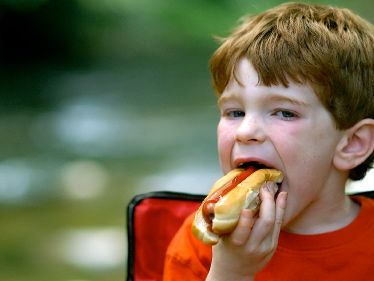
reference-image, l
(article, Kim Carlson)
[%pageBreakSettings nobreak=true] Recently I attended a meeting with fellow parents of teenagers where we were asked what practical know-how we hope our children will gain in the next five years. Progressive and sensible, my fellow parents tossed out such ideas as "Learn to vote," "Figure out birth control," and "Balance a checkbook." When it was my turn, I said, "Learn to feed themselves — to cook and buy the right food." I couldn't be sure, but was that the sound of two dozen eyes rolling? Because we clipped along — "Understand rental information," "Learn to drive," "Figure out taxes" — I didn't get to explain myself. But I'll bet there was more than one parent who wondered, "What did she mean, 'learn to feed themselves?'" Food, after all, is everywhere. Eating requires an appetite, but it hardly takes knowledge. Right? Wrong. Michael Pollan has made that clear. [%image reference-image float=left width=400 caption="Grilled corn, not high-fructose corn syrup."] One of the great paradoxes of our time is food: We produce more food than ever on this planet, and still there is starvation. But at the same time obesity, with all the health problems that accompany it, has reached epidemic levels. The food that’s available to many of us often is “not fit for human consumption,” as nutrition expert Walter Willett says. As a result, an increasing number of us are becoming ill because of what we eat or the frequency with which we eat it. One fat, juicy quarter-pounder with fries and a soda every few weeks won't kill you. But one a day just might. To raise a child in this era of abundance and obesity is to experience things our parents and grandparents could not have foreseen. Things like cutting back on snack time, which has happened in Aliza Wong's son's Texas school. Things like BMI report cards, which (according to a report last summer in the New York Times) many school districts are sending home to parents. (What's a BMI report card? A account of where your child falls on the body-mass index scale, a comparative measure of height and weight.) Cutting back on snacks and sending home BMI report cards are just two of the ways schools are trying to wage war against obesity. Unfortunately, many schools are still serving unhealthy lunches. Fortunately, there are exceptions. Here in Oregon, the state government recently passed a farm-to-school initiative; in Portland, all 10,000 hot-lunch-eating elementary-school students were recently given a slice of roasted beet at lunchtime. The beets, grown on a farm just east of Portland, went over so-so, depending on whom you ask. Slabs of cold beets, I think, may be particularly challenging, although chunks of roasted beets tossed with a little shallot vinaigrette and a sprinkle of blue cheese? Nothing better. (Then again, I wouldn't have thought so as a third-grader.) As school district official Nikole Williams (who runs the Harvest of the Month program) said, exposure is part of the strategy. But while obesity is one reason to teach kids about food, there are other important reasons as well. After all, who are the future stewards of our farmland? Who's going to pass food-friendly legislation in 30 years? Who's going to feed our grandchildren? Sydney Spiesel, writing on Slate a while back, told the story of a Chicago pediatrician named Clara Davis, who conducted studies nearly a century ago in which orphans were given an assortment of foods to eat. Davis found that even though on any given day the children might not eat a balanced diet, over the course of several days they would. She concluded that, left alone, children would choose the diets their bodies required. But here’s the catch: The orphans were not offered sweets (except fruit) or foods high in fat. And of course, they weren't exposed to TV food ads or given soft drinks or chicken nuggets. One can only wonder how the results of the study would have skewed if such popular 21st-century standards as Hot Pockets or Lunchables had been among the choices. Even if long-term testing like this were still being done, it would be almost impossible to control for such pervasive phenomena as advertising or high-fructose corn syrup. (A health provider in Canada has sketched out a typical "high-sugar day" for a hapless 21st century teenage boy in Canada. He ate almost two cups of sugar, all of it hidden in other foods and drinks — in other words, none of it the visible white stuff.) [%image boy float=right width=400 caption="How do we teach kids about food?"] Spiesel's concluding advice on Slate was to give children a balanced diet and then stand back, bite our tongues, and let them choose what to eat. But I would argue that we can't bite our tongues. We need not lecture or be punitive, but we should constantly encourage our children to eat whole foods, to question the value of the foods they like (as well as the advertising that surrounds it), and to see the big picture of food. We have to give our children the skills to feed themselves well — to shop and cook with authority — and encourage them to place a concern for food at the center of their lives. At the same time, we adults have to check ourselves: Are we honing our own food smarts and modeling good-sense eating? Parents can't take on these challenges alone; there are too many other adults with stakes in kids' diets. There are many important reasons to help our children develop good food sense. We all need to look out for the kids. p(bio). Kim Carlson is Culinate's editorial director.

reference-image, l

boy, l

feed-image, l